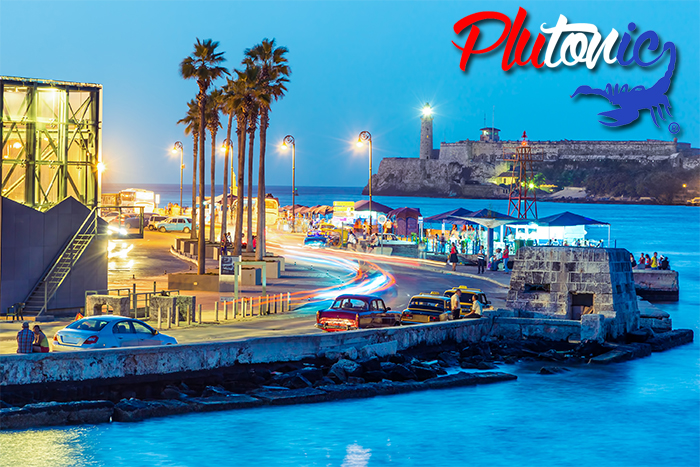A film by TG Herrington and Danny Clinch
Streaming on Prime Video
Review by Ray HoganIt would be both easy and lazy to view “A Tuba To Cuba” as some sort of late-to-the party “Buena Vista Social Club.” The first documentary is better than excellent, but also more than 25 years old. Secondly the Preservation Hall Jazz Band need not play second fiddle to anyone, including the peerless Ry Cooder. The basis of each might be the same but each movie tells its own tale.
The Preservation Hall Jazz Band (and venue) is synonymous with New Orleans, which is universally accepted as the birthplace of jazz. The city is also referred to by locals and musicians as the northernmost point in Caribbean, which is important in making the link between the musical heritage of New Orleans and Cuba.
“New Orleans is magical, it’s mystical. It has stories, It was history” says tuba player and bandleader Ben Jaffe, whose parents opened Preservation Hall in the early 1960s. “And part of understanding our history is understanding the elements that formed who we are as a city and as a people and part of that is in understanding Cuba and the impact its culture and its history has had on our music.”
“A Tuba to Cuba,” directed by TG Herrigton and legendary rock photographer Danny Clinch, documents the The Preservation Hall Jazz Band’s 2015 trip to Cuba in search of its musical and cultural roots.
The film is a work of beauty on several levels. First and foremost has to be the music. The cultural exchange between the Cuban and New Orleans musicians overcomes language barriers to the point of almost being telepathic and obviously beautiful. (The soundtrack is not one in the normal sense but great in its own right. “Keep Your Head Up,” featuring the Cuban singer Eme Alfonso has been lodged in my soul for weeks).
The band makes three major stops — Havana, Santiago de Cuba and the Teatro Terry in Cienfuegos for a formal concert — on it’s journey.
The film’s directors might have made a music documentary but the film itself is also a work of visual allure with scenes filmed through the awesome photographic eye of Danny Clinch. The first of these begins with a young child crushing soda cans to make impromptu tap shoes. This turns into a rhythmic montage that makes viewers want to get on the first plane to Havana to visit. It’s not until the very end that the official concert footage takes place.
This trip also fulfills a dream of Jaffe’s late father to bring traditional NOLA jazz to Cuba in search of common ground.
“From the moment we stepped off the plane there was something immediately familiar,” the younger Jaffe says. “I had a sense of what it must have been like for my parents coming to New Orleans in 1961.”
Preservation Hall (726 South Peter St.) was started in the early 1960s by Ben’s parents, Allan and Sarah, who had relocated from Philadelphia. Allan Jaffe, a tuba player, recognized the need for a place for the traditional jazz players to hang and jam. Louis Armstrong famously stated that Preservation Hall is where you find all the greats. Nearly 60 years later, it serves the same purpose with very few accoutrements or even modern conveniences.
The iteration of the Preservation Hall Jazz Band filmed in 2015 (I believe still the same band) is an amalgamation of superb musicians and even more wonderful human beings.
Aside from the eloquent and educated Jaffe, the soul of the band is split among disparate yet single-minded players. Reedman Charlie Gabriel is the elder statesman and heartbeat of the band. Pianist Rickie Monie is the generous educator. Drummer Walter Harris is a former drug addict who found salvation through percussion while in prison. Saxophonist Clint Maedgen is the young hipster who one wouldn’t think belongs in this environment yet soars to great heights in the world of traditional jazz. Trumpeter Mark Braud and trombonist Ronnell Johnson are legacies, coming through families of NOLA musicians dating back decades. Harris’ recollection of his recovery is heart-warming, while Gabriel plays every role from sage to prankster. Monie is the proud torch-passer. Maedgen is simply cool.
“It is important to have an older generation of culture bearers to ensure the survival of a tradition,” Jaffe says. “They’re the ones that pass it down to the next generation…Something I’ve learned from Charlie Gabriel is that cultural conversation cancels out complication.”
The discoveries the New Orleanians come upon are too numerous to mention. Among them are pictures of Jaffe’s father and uncle that he finds on the wall of the Havana hangout Casa de Jazz. Another is Harris’ tearful interaction with Cuban musicians at a shrine to music, soul and Africa. A visit to a guitar luthier becomes a spiritual excursion. It probably goes without saying that street parades are central to both cultures.
“We came here on this musical journey and found this piece of us that’s been missing for over 60 years,” Jaffe says before fading to a lovely scene of saxophonist Clint Maedgen blowing beautiful in a historic alcove/archway. That impromptu interlude becomes the opening tune to the soundtrack.
I’ve watched more musical documentaries in the last year than I should probably admit. “A Tuba to Cuba” might be the best among them. The Preservation Hall Jazz will tour in support of this film next month. I will be there opening night!
A Tuba to Cuba

24
Sep

